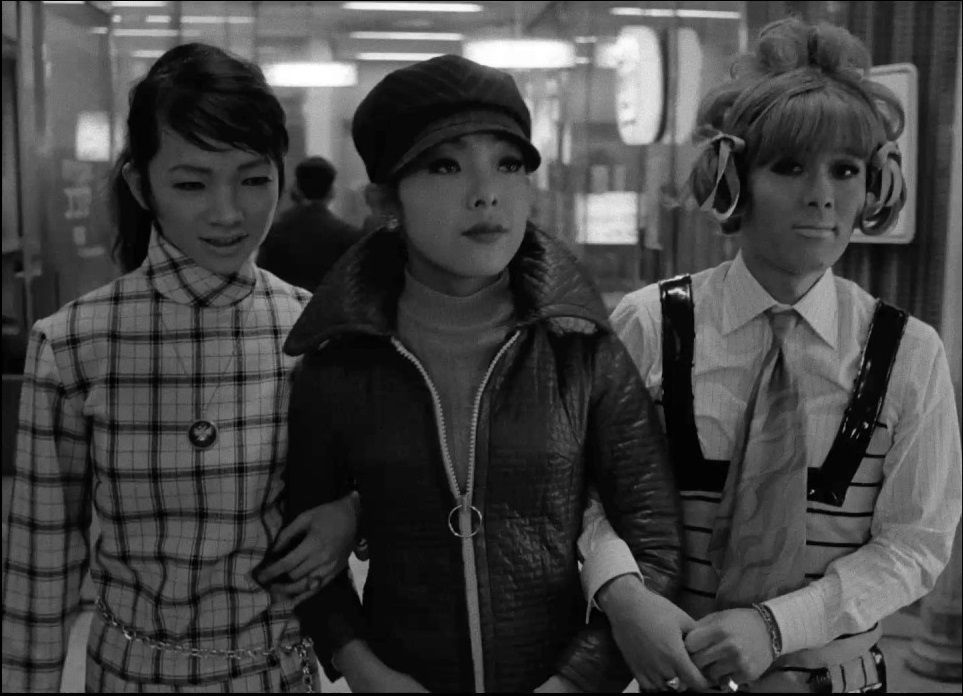Queer cinema has been around for virtually as long as cinema has existed, but it often was forced to exist in the subtext of works or exist as small, independent productions that travelled through an underground network of dedicated cinephiles. This was especially prevalent in markets that didn’t have to compete with the monolithic Hollywood system directly, and one of these underground films was Toshio Matsumoto‘s 1969 film Funeral Parade of Roses, a transgender-centric art film that was less concerned with delivering a conventional plot structure than it was with examining the unconventional lives of Japanese “gay boy” culture. With the film receiving a Blu-ray release following a gorgeous 4K restoration, now is as good a time as any to look at what made Funeral Parade of Roses so extraordinary.
The term “rose” in Japanese culture carries much the same connotation as “pansy” does in English vernacular, often used as a derisive term for perceived males who present feminine attributes. Furthermore, much like elsewhere in the world in the 1960s, gay and transgender identity were often conflated, with crossdressing and transgenderism uniformly lumped into the Japanese subculture known as “gay boys,” whose feminine appearance made it more acceptable for masculine gay men to flirt with them in drag bars. Funeral Parade of Roses focuses on a hostess of one such drag bar, Eddie (portrayed by transgender actress Peter) as she engages in an affair with the club’s owner, Gonda (Yoshio Tsuchiya). However, the madame of the drag bar, Leda (Osamu Ogasawara), is also sleeping with Gonda, and she sees Eddie’s encroachment on her lover as a threat to her power, bringing tensions between the two to a head.
However, to call this the main plot of Matsumoto’s film would be somewhat disingenuous, as the filmmaker is much less concerned with plotted narrative than it is with demonstrating the life of a “gay boy” and questioning what could motivate someone to live their life as a shunned outcast. We follow Eddie through a life of partying and unabashed hedonism, hanging out with other social outcasts in dark corners and unrepentantly exploring her sexuality. Funeral Parade of Roses is a very sexually explicit film, but it always emphasizes the sensuality of its sex scenes rather than the queer novelty. Eddie’s nudity is highlighted for the apparent mismatch between her made-up face and her lack of breasts, but we’re never made to gawk or deride her body; her sexuality is to be celebrated as much as anyone’s, which is a remarkably progressive attitude for a film to have taken nearly fifty years ago.
But Matsumoto was a notoriously experimental filmmaker, so much as we are meant to question our understanding of Eddie’s gender and sexuality—which the film comes very close to uncoupling as synonymous—we are also made to question our basic understanding of cinematic narrative construction. The chronological order of events is played with, long diversions from the central love triangle plot take up the majority of the second act, and we are often introduced to characters that have little bearing on Eddie’s conflicts. Matsumoto doesn’t stop there, though, as he gets a lot more metafictional with his experimentation. Actresses are pulled aside for interviews about their real lives as “gay boys;” we see footage of the film crew during filming and cuts still include the presence of a clapperboard; segments of avant garde short films weave their way into the fabric, and persistent title cards reinforce the artificiality of cinematic presentation. Each of these techniques are designed to make us question what makes a film, just as Eddie (and to some extent the actress portraying her) is a direct challenge to classical definitions of male and female.
And Funeral Parade of Roses pushes those limits both textually and metatextually, taking extreme turns that push the boundaries of good taste and narrative cohesion. To divulge too much of the film’s third act would be telling, but there are extreme shades of what might have later inspired John Waters and Park Chan-wook, drawing limits on what the film’s characters will accept as sexually permissive even as they break taboos by their very existence. Stanley Kubrick explicitly cited the film as a major influence on his version of A Clockwork Orange. The film comes to a surprisingly violent and discordant end for an otherwise liberating and culturally empathetic piece, but reconciling that disharmony is precisely what the film’s creator intended.
For this writer, Funeral Parade of Roses was a recent discovery, but it has readily established itself as an important piece of queer film history in my mind. It is wildly progressive beyond its era, and it poses major questions about gender and sexuality without belittling or moralizing to the transgender women it portrays. Matsumoto comes from a place of genuine curiosity, and his exploration is both artistically engaging and philosophically sound. If you like queer or arthouse cinema, or undefinable works of art, Funeral Parade of Roses is a must-see.













